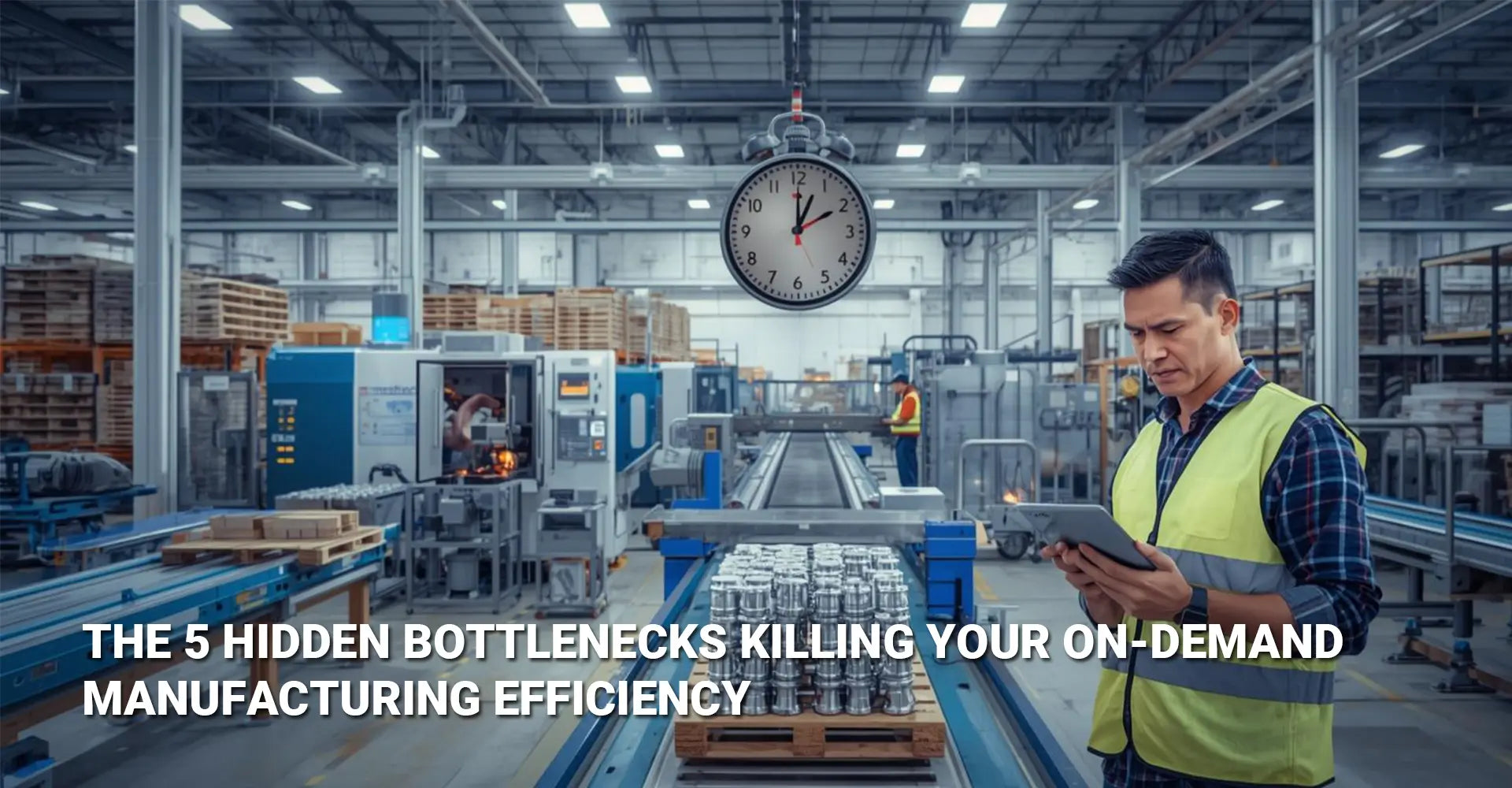What's Really Slowing Down Your On-Demand Manufacturing Process?

What's Really Slowing Down Your On-Demand Manufacturing Process?

You requested a quote on Monday morning. By Friday afternoon, you're still waiting. Sound familiar? This frustrating scenario happens every day in manufacturing facilities across the country. While suppliers promise quick turnarounds and flexible production, the reality often falls short. In fact, many businesses experience delays that push their product launches back by weeks or even months. Understanding why these delays happen is crucial for anyone managing custom part production or coordinating supply chains.
What You Need to Know Right Now
Key Takeaways:
- Manual quoting processes add 3-5 business days to every project before work even starts
- "Available capacity" doesn't guarantee immediate production starts due to hidden scheduling conflicts
- Quality inspection delays often occur after parts are actually finished, creating invisible waiting periods
- Information handoffs between departments cause up to 70% of unexpected delays in the workflow
- Transparent communication tools can help identify bottlenecks before you place orders with suppliers
These issues affect everything from automotive manufacturing to industrial machinery production. Moreover, they create ripple effects throughout your entire project timeline.
Why This Matters to Your Business
The gap between what manufacturers promise and what they deliver creates real business problems. Therefore, identifying the specific bottlenecks in your supply chain becomes a competitive advantage. In this article, we'll explore the five most common delays that slow down production. Additionally, we'll provide practical solutions you can implement immediately. By the end, you'll know exactly which questions to ask potential suppliers and how to spot warning signs before they become costly problems.
Table of Contents
- Why Does Getting a Quote Take So Long?
- What Does "Available Capacity" Actually Mean in Custom Manufacturing?
- Where Do Parts Get Stuck After Quality Checks?
- How Do Real Manufacturers Experience These Delays?
- What Steps Can Eliminate These Bottlenecks?
Why Does Getting a Quote Take So Long?
The Quoting Bottleneck Explained
Getting a simple quote shouldn't feel like pulling teeth. However, traditional manufacturing shops often take 3-5 business days just to provide pricing. This delay happens right at the start of your project, pushing back every subsequent milestone. Consequently, understanding the on demand manufacturing process begins with understanding why quoting takes so long.
The Four Manual Steps Slowing You Down
Traditional quoting involves several time-consuming manual steps:
- CAD file review - Engineers must open each design file individually and assess complexity
- Machining time calculations - Calculating how long each operation takes requires manual estimation
- Material sourcing checks - Staff must contact multiple suppliers to verify availability and pricing
- Management approvals - Quotes often require sign-off from multiple departments before sending
Each of these steps creates a handoff point where information can stall. Furthermore, if engineers have questions about your design, the back-and-forth communication adds even more time.

How Digital Systems Change the Game
Automated quoting systems can dramatically reduce this timeline. These platforms analyze CAD files instantly using algorithms that recognize common features and calculate machining times. As a result, what once took days now takes hours or even minutes. Digital systems also integrate directly with material supplier databases, eliminating the need for manual sourcing calls. In addition, they provide instant feedback on design modifications that could reduce costs or lead times.
For businesses working with CNC metals and plastics, this speed advantage becomes especially important. Materials pricing fluctuates frequently, so real-time quotes reflect actual current costs rather than outdated estimates.
What Does "Available Capacity" Actually Mean in Custom Manufacturing?
The Capacity Misconception
A machine shop tells you they have available capacity next week. Great news, right? Not necessarily. The phrase "available capacity" often conceals several hidden roadblocks that prevent immediate production starts. Understanding these obstacles helps manage expectations and plan more accurate timelines for the rapid manufacturing supply chain.
Four Hidden Factors Blocking Production
Available capacity rarely means your job can start immediately because of these factors:
- Tooling and fixture setup - Each new job requires specific tools to be installed and calibrated, which can take 4-8 hours
- Operator scheduling conflicts - The machine might be free, but the specialized operator who knows how to run it isn't available
- Material lead times - Even when the machine is ready, your specific material grade might not be in stock yet
- Quality documentation preparation - First article inspection plans and measurement protocols must be created before production begins
These factors combine to create a gap between theoretical capacity and practical readiness. Therefore, always ask suppliers about their actual start date, not just whether they have capacity.
Questions to Ask About Real Capacity
When evaluating suppliers, dig deeper than surface-level availability claims:
- "What is the typical setup time for jobs similar to mine?"
- "Do you have the specific material grade I need in stock right now?"
- "Which operator will run my job, and when are they next available?"
- "How long does it take to prepare quality documentation for a new part?"
These questions reveal whether a supplier has truly addressed digital manufacturing bottlenecks or simply has empty machine time. Additionally, they help you understand the realistic timeline from order placement to production start.
Where Do Parts Get Stuck After Quality Checks?
The Quality Limbo Problem
Your parts passed inspection three days ago. So why haven't they shipped yet? This frustrating phenomenon, often called "quality limbo," happens more frequently than most people realize. In fact, administrative processes after quality approval often take longer than the inspection itself. This creates unexpected custom part production delays that are completely invisible to customers.
Four Post-Inspection Delays
After parts pass quality checks, they still must go through several administrative steps:
- Engineering approval waiting - The inspection report sits in someone's inbox waiting for final sign-off
- Packaging materials shortages - Custom foam inserts or specialty boxes aren't available when needed
- Shipping documentation preparation - Commercial invoices, certificates of conformance, and packing lists take time to generate
- Accounting processing - The invoice must be created and approved before shipping can proceed
Each of these steps represents a potential stopping point. Moreover, because the manufacturing work is "done," these delays often receive less attention and urgency from the production team.
How Integrated Systems Prevent Limbo
The solution lies in treating shipping as an integrated part of production rather than a separate afterthought. Smart manufacturers prepare shipping documentation during production, not after. They also maintain adequate packaging material inventory and establish clear approval workflows with built-in time limits.
When evaluating suppliers for surface finish requirements or other specifications, ask specifically about their post-inspection processes. Request metrics on average time from quality approval to actual shipment. This single data point reveals how well-organized their back-end processes really are.
How Do Real Manufacturers Experience These Delays?
Learning from Real-World Experiences
Theory is helpful, but nothing beats learning from actual experiences. Manufacturing forums and communities reveal patterns in how these bottlenecks manifest in real production environments. By analyzing common complaints, we can identify which problems occur most frequently and cause the most frustration.
Three Common Complaint Patterns
Based on discussions in manufacturing communities, these themes appear repeatedly:
- The disappearing sales rep - "Got a quote in two days, placed the order, and haven't heard anything for three weeks"
- The mysterious capacity problem - "They said they had capacity, took my deposit, then told me they're backed up for six weeks"
- The shipping black hole - "Parts were done two weeks ago according to the tracking system, but they still haven't shipped"
These patterns align perfectly with the bottlenecks we've discussed. Furthermore, they highlight how poor communication amplifies the frustration caused by delays. Customers can accept some delays if they understand what's happening and why.
![f]rustrated workers in safety vests gathered around a pallet of completed metal parts checking their watches and looking at clipboards with concern](https://cdn.shopify.com/s/files/1/0915/0434/5380/files/f_rustrated_workers_in_safety_vests_gathered_around_a_pallet_of_completed_metal_parts_checking_their_watches_and_looking_at_clipboards_with_concern.webp?v=1762831507)
The Communication Gap
What's striking about these real-world examples is how often the technical work gets done on time, but communication failures create the perception of disaster. A supplier might be working diligently on solving a material sourcing issue, but if they don't communicate this to the customer, it feels like nothing is happening.
This insight reveals an important truth about on-demand production challenges: many aren't purely technical problems. Instead, they're information flow problems that could be solved with better visibility and communication systems. Suppliers who invest in customer portals, automated status updates, and proactive communication consistently receive better reviews, even when they encounter the same technical challenges as competitors.
What Steps Can Eliminate These Bottlenecks?
Your Action Plan for Faster Production
Now that we've identified the five major bottlenecks, let's focus on solutions. Whether you're sourcing parts for the first time or looking to improve existing supplier relationships, these five steps will help you achieve more predictable timelines and reduce frustrating delays in manufacturing quote to delivery.
Step 1: Qualify Suppliers on Speed Metrics
Don't just ask if a supplier can make your part. Instead, request specific performance data:
- Average quote turnaround time for similar complexity parts
- Percentage of jobs that ship on the original promised date
- Average time from quality approval to shipment
- Typical setup time for new jobs in your material and complexity range
Suppliers who track these metrics demonstrate a commitment to continuous improvement. Moreover, their willingness to share data shows transparency and confidence in their processes.
Step 2: Demand Real-Time Visibility
Request access to production tracking systems before placing orders. The best suppliers offer customer portals where you can see:
- Current production stage for your parts
- Quality inspection results as they happen
- Shipping preparation status
- Estimated completion dates that update automatically
This visibility doesn't just reduce your anxiety. It also allows you to coordinate downstream activities more effectively. Additionally, it puts pressure on suppliers to maintain accurate data, which improves their internal processes.
Step 3: Address Material Lead Times Upfront
Material availability causes more delays than most people realize. Therefore, discuss material sourcing during the quoting phase:
- Ask if your specific material grade is in stock or needs to be ordered
- Request lead time estimates for materials that must be sourced
- Consider alternative materials that might be readily available
- Discuss minimum order quantities that might affect small batch runs
For businesses dealing with small batch supply chain issues, material sourcing becomes even more critical. Suppliers sometimes prioritize large orders when allocating inventory, leaving small orders waiting for the next material shipment.
Step 4: Establish Communication Protocols
Set clear expectations about communication frequency and methods:
- Weekly status updates at minimum, even if there's no progress to report
- Immediate notification of any issues that might affect the timeline
- Single point of contact who has authority to answer questions
- Response time commitments for emails and calls
These protocols might seem excessive, but they prevent the "disappearing supplier" problem. Furthermore, they force suppliers to stay on top of your project rather than letting it drift.
Step 5: Build Long-Term Partnerships
The most reliable way to eliminate bottlenecks is working with the same qualified suppliers repeatedly. Long-term relationships provide several advantages:
- Suppliers learn your quality standards and design preferences
- You move to the front of the queue when capacity gets tight
- Trust builds on both sides, reducing excessive documentation requirements
- Continuous improvement happens naturally through regular feedback
When working with specialized suppliers for automotive or industrial machinery applications, this partnership approach becomes especially valuable. Complex parts benefit from the institutional knowledge that builds up over multiple orders.
Conclusion
Taking Control of Your Manufacturing Timeline
The five bottlenecks we've explored—slow quoting, capacity confusion, quality limbo, information handoffs, and post-inspection delays—account for most frustrating experiences in custom manufacturing. However, none of these problems are unsolvable. By understanding where delays originate, you can ask better questions, choose better suppliers, and set more realistic expectations.
The shift from traditional to digital manufacturing continues to accelerate. Suppliers who embrace automation, transparency, and integrated workflows will increasingly separate themselves from competitors still relying on manual processes. Therefore, your choice of manufacturing partner matters more than ever.
Start by auditing your current suppliers using the questions and metrics provided in this article. Identify which bottlenecks affect your projects most frequently. Then, work collaboratively with suppliers to address these issues, or begin exploring alternatives who have already solved these problems.
Remember that manufacturing delays create cascading effects throughout your business. A three-day quoting delay doesn't just push back production by three days—it affects product launches, customer commitments, and revenue recognition. Consequently, investing time in selecting the right suppliers and establishing strong processes pays dividends far beyond the immediate project.
The businesses that thrive in competitive markets are those who master their supply chains. By eliminating these five hidden bottlenecks, you'll gain a significant advantage in speed, reliability, and overall competitiveness.
Recommended Resources
[on demand manufacturing process][^1]
[digital manufacturing bottlenecks][^2]
[custom part production delays][^3]
[rapid manufacturing supply chain][^4]
[on-demand production challenges][^5]
[manufacturing quote to delivery][^6]
---
[^1]: Understanding the on demand manufacturing process can help businesses optimize production and reduce waste.
[^2]: Exploring digital manufacturing bottlenecks can provide insights into improving efficiency and productivity in manufacturing.
[^3]: Understanding the causes of delays can help businesses mitigate risks and improve their production timelines.
[^4]: Exploring this topic reveals how rapid manufacturing can enhance efficiency and responsiveness in supply chains.
[^5]: Understanding these challenges can help businesses optimize their production processes and improve efficiency.
[^6]: Exploring this process can provide insights into improving lead times and customer satisfaction in manufacturing.





